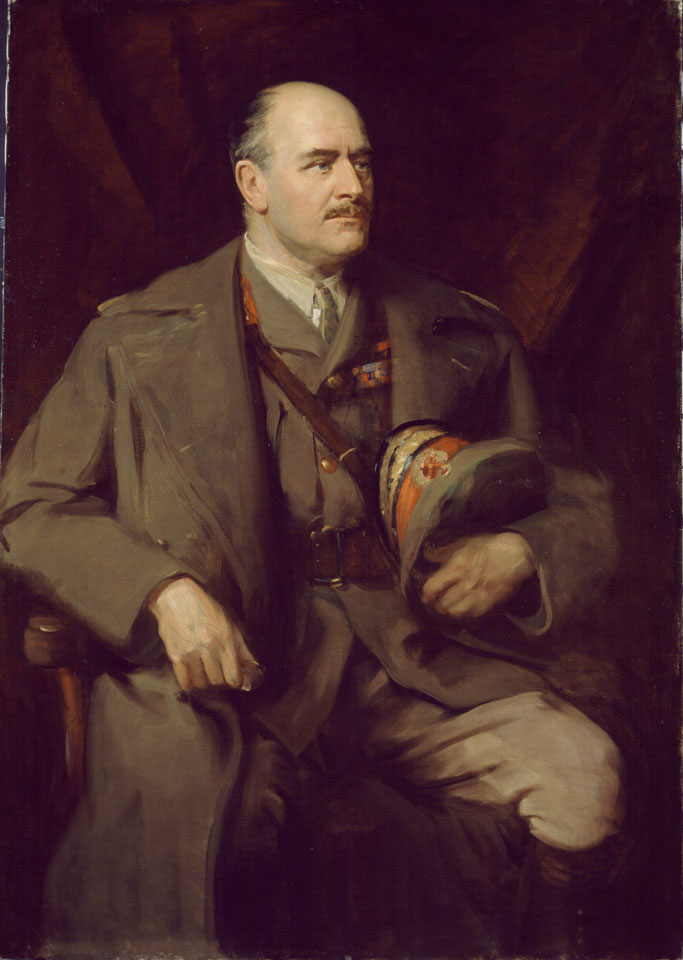
Online Collection
Field Marshal Lord Allenby of Megiddo and Felixstowe GCB, GCMG, 1925 (c)
Oil on canvas by Samuel Fisher (1856-1939), 1925 (c).
Allenby (1861-1936) was commissioned into the 6th (Inniskilling) Dragoons in 1881, serving in South Africa before returning to Britain to attend Staff College. By 1898 he was a brigade-major with the 3rd Cavalry Brigade. During the Boer War (1899-1902) he served with General French's Cavalry Division, earning himself a reputation as a bold and resourceful commander, particularly during the anti-guerrilla operations. Allenby returned home in 1902 to command the 5th Royal Irish Lancers. Promoted to brigadier-general, Allenby assumed command of the 4th Cavalry Brigade in 1905. In 1909 he was promoted to major-general and appointed Inspector-General of Cavalry. During this period he encouraged a re-assessment of the cavalry's role in modern warfare, steering a path between the traditionalists and those who favoured the use of mounted infantry.
During World War One (1914-1918) Allenby commanded the British Expeditionary Force's Cavalry Division, winning praise for his leadership during the retreat from Mons (1914). He later commanded the Cavalry Corps, and in 1915 led the 5th Corps during the 2nd Battle of Ypres (April-May 1915). In October 1915 he took charge of the 3rd Army. Like many other generals, Allenby struggled to come to terms with the new technological warfare. At Arras (April-May 1917), his forces failed to exploit a breakthrough and he was replaced by General Byng, although his removal and transfer owed much to his feud with Field Marshal Haig, whose judgements he had ceased to trust.
Allenby took command of the Egyptian Expeditionary Force (EEF) in June 1917 and set about improving its organisation, efficiency and discipline. He also embarked on morale-boosting visits to the front, something his predecessor had neglected. Allenby also encouraged irregular warfare, increasing support for Colonel T. E. Lawrence's revolt. These changes revitalised the campaign. Victory during the 3rd Battle of Gaza (October-November 1917) was followed by the capture of Jerusalem (December 1917), an event that made him a national hero. The need to reinforce the Western Front during the German Spring Offensive meant that Allenby lacked the troops necessary to push on, but in August 1918 enough men had arrived to resume the offensive. Victory at Meggiddo (September 1918) secured the decisive break through and the EEF quickly advanced, taking Damascus and Aleppo, before the Turks sued for peace in October 1918.
Made a field marshal in 1919, he remained in the Middle East as High Commissioner for Egypt and Sudan until 1925. Allenby was often abrupt with his subordinates and a stickler for presentation and discipline; traits that combined with his physical stature led people to nickname him 'The Bull'. Nevertheless, he can be regarded as one of the most successful commanders of the war, using strategies in Palestine that he developed from his experiences in South Africa and on the Western Front. His leadership at Megiddo in particular, with its skilful series of manoeuvres and use of aeroplanes, artillery, infantry and cavalry, is considered by many to be a forerunner of the German 'Blitzkrieg' tactics of 1939-1940.
NAM Accession Number
NAM. 2003-05-169-1
Copyright/Ownership
National Army Museum, Out of Copyright
Location
National Army Museum, Study collection
Object URL
https://collection.nam.ac.uk/detail.php?acc=2003-05-169-1

